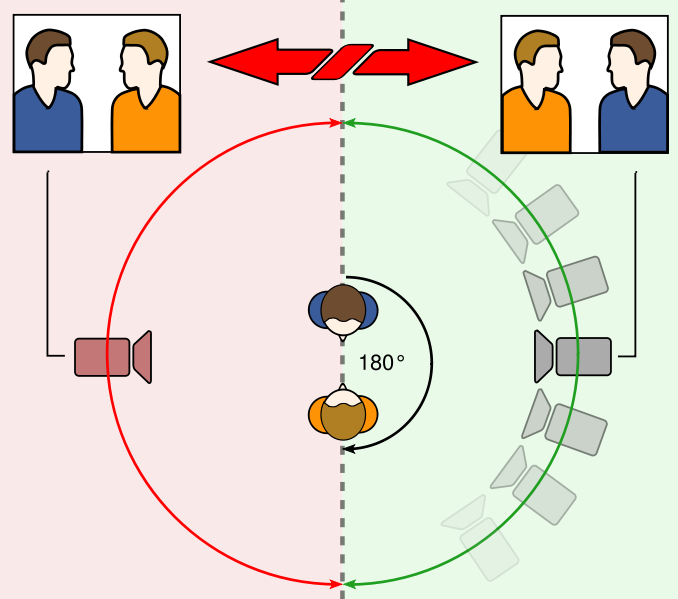Editing II
Spatial Relations
Editing is one of the tools filmmakers have available to provide the audience with an accurate sense of the space where the action takes place.
Traditional film making starts creating a general view of the whole space (normally with a long shot), and follows this with a series of shots of different parts of the location.
In North by Northwest, Alfred Hitchcock starts the famous scene of the airplane chase with a general view of the open landscape. In the next shots, he gives us clues about all the elements that will play a key role in the climactic moment. When the action comes, the audience knows exactly where every single step is taking place.
The human brain tends to close the gaps. Editing counts of this human capability to make the narration more dynamic.
The classic example: The film audience sees a speaker on the screen. In the next shot, the filmmaker shows us a cheering crowd. Our brain will close the gap and perceive that both actions are happening in the same location.
When we described the Kuleshov effect in the first learning unit on editing, we show how the juxtaposition of shots really helps create meaning beyond dialogues or performance.
Temporal Relations
Like any other film techniques, editing can also control the time of the action.
There are different techniques to control timing through editing. Some of them, we have already discuss in the learning unit dedicated to narrative time.
Chronological Order
I am directly referring here to the most common techniques to alter or disrupt the chronological order of the story, which called “Anachrony” there:
Analepsis (or Flashback)
Ellipsis
The ellipsis is a rhetorical figure (or trope) consisting in removing – or excluding – from the narration parts that the author does not consider indispensable.
Through editing, we can control the screen duration of the different events the story contains, so that they take last time on the screen than they would have taken in reality.
This is particularly relevant for events for
- transitions
- and repetitive events.
Transitions
In the following sequence of Gladiator (Ripley Scott, 2000), The main character travels on horseback from Germania (what we call Germany today) to Hispania (currently Spain). The physical distance between those locations is around 5000 miles. The whole sequence just las a couple of seconds
Repetitive Events
In order to escape from prison, the main character in Escape from Alcatraz, had to repeat the same actions every night for, perhaps, several years. Don Siegel uses a ellipsis to show those repetitive events.
Time Expansion
Sometimes, the story requires the expansion of the time of the story.
In this case, the author does the opposite of the ellipsis. Instead of reducing the time of the action, they expand it, so that the duration of the scene or action is longer than the actual time.
- slow motion
- overlapping shots
Slow Motion
Sam Peckinpah used slow motion in the most effective way to depict violence in his crepuscular Westerns. The way cinema approach the depiction of violence dramatically changed after The Wild Bunch (1969).
Overlapping and Repetitive Shots
We have already used Taxi Driver as an example of excellence in filmmaking.Martin Scorsese effectively uses repetition and overlapping of shots in different moments of the movie to emphasize the oppressive atmosphere that surrounds Travis’s life.
Repetition and overlapping of shots help the filmmaker expands a time that actually goes nowhere. Travis has entered a mental dead-end.
Continuity Editing
Around 1900-1910, filmmakers started to experiment editing techniques to create meaning.
Those pioneers developed system to organize the different shots in the most intelligible and clear way. The goal was to structure the filmic discourse in a fashion that made sense for the audience.
We will refer in this learning unit to those editing techniques as narrative continuity.
The style the pioneers created was so powerful that today everybody working in filmmaking must be thoroughly familiar with it.
Narrative Continuity
Editing techniques aim to solidify the narrative cohesiveness. The chain of events that make up the story needs editing in order to glue together all the shots that make up the film. Through those techniques, the audience perceive the movie as a coherent continuum.
Editing should take into account the nature of our human brain.
We need more time to process the large amount of information a long shot may contain than the information of a close up. Thus, this last type of shot is normally shorter than the long one.
Apropos coherence and cohesiveness, watch following scene of Mel Gibson’s blockbuster Braveheart (1995).
Our discussion forum on Editing will contain a thread so that you can share your analysis of this scene.
Spatial Continuity: The 180 Degree Rule
The 180° rule defines where to place the camera in the process of filmmaking in order to keep the sense of special continuity.
That rule is defined by the “Axis of Action”, an imaginary line that the filmmaker cannot cross without breaking the rule of continuity.
This axis determines a 180° area in the set.

If we position the camera in any place beyond this circle (on the other side of the axis of action, the red camera in the picture), the spectator will lose the spatial orientation.
In this video, you can learn more about the canonic way of using this rule to construct the spatial perception of the audience:
